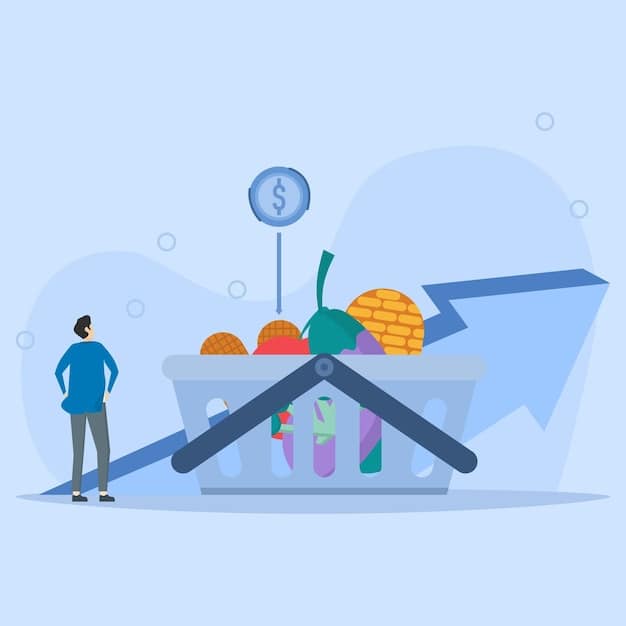Federal Reserve’s New Inflation Measures: A Deep Dive Analysis

Federal Reserve Announces New Measures to Combat Inflation: A Detailed Analysis of the strategies, including interest rate adjustments and balance sheet management, aimed at curbing rising inflation in the U.S. economy.
The Federal Reserve Announces New Measures to Combat Inflation: A Detailed Analysis is crucial for understanding the central bank’s strategies in response to rising price levels. These measures, which include adjustments to interest rates and modifications to the Fed’s balance sheet, have far-reaching implications for consumers, businesses, and the overall economy.
Understanding the Federal Reserve’s Mandate
The Federal Reserve, often referred to as the Fed, operates as the central bank of the United States. Its primary mandate is to promote maximum employment and stable prices, along with moderating long-term interest rates. These goals collectively contribute to a healthy and stable economy.
The Dual Mandate Explained
The Fed’s dual mandate is a balancing act. It must navigate the complexities of promoting job growth while keeping inflation under control. This requires a delicate approach, as policies aimed at stimulating employment can sometimes lead to inflationary pressures.
Tools the Fed Uses
To achieve its mandate, the Fed employs several key tools. These include:
- Interest Rate Adjustments: Adjusting the federal funds rate, the target rate that commercial banks charge one another for the overnight lending of reserves.
- Open Market Operations: Buying and selling U.S. government securities to influence the money supply and credit conditions.
- Reserve Requirements: Setting the fraction of a bank’s deposits that must be kept in reserve either in its account at the Fed or as vault cash.
Understanding these tools is crucial for interpreting the Fed’s actions and their potential impact on the economy.
In summary, the Federal Reserve operates with a dual mandate, employing various tools to maintain economic stability. Its decisions are closely watched by economists, investors, and the general public, as they can significantly influence financial conditions and economic growth.
Inflation: The Economic Challenge
Inflation, defined as a general increase in prices and a fall in the purchasing value of money, poses a significant challenge to economic stability. High inflation erodes the value of savings, reduces consumer purchasing power, and can lead to economic uncertainty.

Causes of Inflation
Inflation can arise from various factors, including:
- Demand-Pull Inflation: Occurs when there is an increase in aggregate demand that outpaces the economy’s ability to produce goods and services.
- Cost-Push Inflation: Arises when the cost of production increases, leading businesses to raise prices.
- Built-In Inflation: Is related to adaptive expectations and often is linked to the price/wage spiral.
Understanding the underlying causes of inflation is essential for developing effective strategies to combat it.
Impact on Consumers and Businesses
Inflation affects both consumers and businesses in several ways:
- Reduced Purchasing Power: Consumers can buy less with the same amount of money.
- Increased Uncertainty: Businesses may find it difficult to plan for the future.
- Higher Borrowing Costs: Interest rates may rise in response to inflation.
These impacts underscore the importance of maintaining price stability for a healthy economy.
In conclusion, inflation presents a complex challenge that can stem from various sources and significantly impact consumers and businesses. Effective monetary policy is crucial for managing inflation and promoting economic stability.
Details of the Federal Reserve’s New Measures
In response to persistent inflationary pressures, the Federal Reserve has announced a series of new measures designed to curb rising prices. These measures represent a concerted effort to restore price stability and maintain a healthy economy.
Interest Rate Hikes
One of the primary tools the Fed is using is raising interest rates. By increasing the federal funds rate, the Fed aims to make borrowing more expensive, thereby reducing demand and slowing down economic activity. This, in turn, should help to cool down inflationary pressures.
Balance Sheet Adjustments
In addition to raising interest rates, the Fed is also adjusting its balance sheet. This involves reducing the Fed’s holdings of U.S. government securities and agency mortgage-backed securities, which were accumulated during periods of quantitative easing. Reducing the balance sheet is intended to further tighten financial conditions.
Forward Guidance
The Fed also provides forward guidance to communicate its intentions to the public. This involves signaling the likely path of future interest rate adjustments and balance sheet policies. Clear communication is intended to manage expectations and reduce uncertainty in the markets.
These measures collectively represent a comprehensive approach to combating inflation. The Fed’s actions are aimed at reducing demand, tightening financial conditions, and managing expectations to restore price stability.

Potential Impact on the U.S. Economy
The Federal Reserve’s new measures to combat inflation are expected to have a significant impact on the U.S. economy. These policies will likely affect various sectors and stakeholders, with both positive and negative consequences.
Impact on Consumers
Consumers are likely to feel the effects of higher interest rates in several ways:
- Increased Borrowing Costs: Mortgages, auto loans, and credit card rates may rise.
- Reduced Spending: Higher borrowing costs may lead to decreased consumer spending.
- Potential Job Losses: Slower economic growth could lead to job losses in some sectors.
Despite these challenges, controlling inflation is crucial for maintaining long-term purchasing power.
Impact on Businesses
Businesses will also be affected by the Fed’s new measures:
- Higher Borrowing Costs: Companies may face higher costs for financing investments and operations.
- Reduced Demand: Slower economic growth could lead to reduced demand for goods and services.
- Potential for Layoffs: Some businesses may need to reduce their workforce in response to slower growth.
However, stable prices can provide a more predictable environment for business planning and investment.
In assessing the potential impact, it’s important to consider the trade-offs between controlling inflation and promoting economic growth. The Fed’s goal is to strike a balance that supports long-term economic health.
Expert Opinions and Analysis
Economists and market analysts have offered various perspectives on the Federal Reserve’s new measures to combat inflation. These opinions reflect a range of views on the likely effectiveness and potential consequences of the Fed’s policies.
Differing Viewpoints
Some experts believe that the Fed’s actions are necessary to prevent inflation from becoming entrenched. They argue that decisive measures are needed to restore price stability and maintain confidence in the economy.
Others express concerns that the Fed’s policies could lead to a recession. They argue that raising interest rates too aggressively could choke off economic growth and lead to job losses.
Key Considerations
In evaluating these differing viewpoints, it’s important to consider:
- The Pace of Rate Hikes: How quickly the Fed raises interest rates will be a key factor.
- The Magnitude of Balance Sheet Adjustments: The extent to which the Fed reduces its balance sheet will also matter.
- The Response of Inflation: How quickly inflation responds to the Fed’s measures will be crucial.
Ultimately, the success of the Fed’s policies will depend on a variety of factors, including the evolution of the global economy and the response of businesses and consumers.
Alternative Strategies and Potential Outcomes
While the Federal Reserve is pursuing a specific set of measures to combat inflation, alternative strategies could also be considered. Understanding these alternatives and their potential outcomes is important for a comprehensive analysis.
Alternative Policies
Some alternative policies that have been suggested include:
- Supply-Side Reforms: Implementing policies to increase the economy’s productive capacity, such as tax cuts or deregulation.
- Wage and Price Controls: Imposing direct controls on wages and prices to limit inflation.
- Fiscal Policy Measures: Using government spending and taxation to influence aggregate demand and inflation.
Potential Outcomes
Each of these alternative strategies carries its own set of potential outcomes:
- Supply-Side Reforms: Could boost economic growth and reduce inflationary pressures, but may take time to implement.
- Wage and Price Controls: Could temporarily suppress inflation, but may lead to distortions and shortages.
- Fiscal Policy Measures: Could influence demand and inflation, but may be subject to political constraints.
A balanced approach that combines monetary policy with other strategies may be the most effective way to address inflation while promoting sustainable economic growth.
| Key Point | Brief Description |
|---|---|
| 📈 Interest Rate Hikes | Increasing borrowing costs to reduce demand and slow down economic activity, cooling inflationary pressures. |
| ⚖️ Balance Sheet Adjustments | Reducing holdings of U.S. government securities to tighten financial conditions and further curb inflation. |
| 🗣️ Forward Guidance | Communicating intentions clearly to manage expectations and reduce uncertainty in the markets. |
| 💼 Impact on Businesses | Businesses may face higher borrowing costs and reduced demand, but stable prices offer predictability. |
Frequently Asked Questions
▼
The Federal Reserve’s primary goal is to promote maximum employment and stable prices in the U.S. economy. This is often referred to as its dual mandate.
▼
The Federal Reserve is raising interest rates to combat inflation. Higher interest rates make borrowing more expensive, which can help to cool down demand and slow down price increases.
▼
Consumers may face higher borrowing costs for mortgages, auto loans, and credit cards. This could potentially reduce spending and, in some cases, lead to job losses.
▼
Alternative strategies include supply-side reforms, wage and price controls, and fiscal policy measures. Each of these carries its own set of potential benefits and drawbacks.
▼
Forward guidance is a communication tool used by the Federal Reserve to signal its intentions regarding future monetary policy. It helps manage expectations in the markets.
Conclusion
The Federal Reserve’s recent announcement of new measures to combat inflation marks a critical juncture in the U.S. economic landscape. By understanding the rationale behind these measures, their potential impacts, and alternative strategies, stakeholders can better navigate the challenges and opportunities that lie ahead, contributing to a more stable and prosperous economic future.





